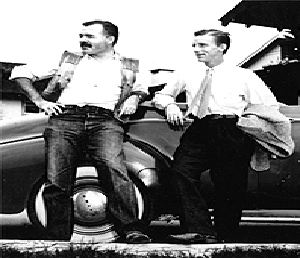UNITED STATES—You could say he ate to sweat and he sweat to eat.
As an avid athlete, Hemingway had a sharp awareness of being in shape and out of shape. He could appreciate fitness from sparring in the boxing ring, wrestling with marlin, and being at the race track. In the opening to the early story, “My Old Man,” there lurks a judgmental attitude toward fitness, equating fat with moral sloppiness. You can work up a sweat just reading this passage about his expat jockey dad:
“I guess looking at it now my old man was cut out for a fat guy, one of those regular little roly fat guys you see around, but he sure never got that way, except a little toward the last, and then it wasn’t his fault, he was riding over the jumps only and he could afford to carry plenty of weight then. I remember the way he’d pull on a rubber shirt over a couple of jerseys and a big sweat shirt over that, and get me to run with him in the forenoon in the hot sun.”
Hemingway went on many cross country trips in the 30s with chauffeur, handyman, traveling companion and friend, Toby Bruce. They usually shared a room when they traveled together, and ate country ham and egg sandwiches with sliced raw onion for breakfast. Hemingway was worried about keeping his weight down and did exercises on the bed in the morning. (That’s one way to get your morning exercise!) After breakfast, he jogged along the road for about three miles. His travel companion would give him a head start then pick him up on the way out of town. In Sun Valley he was observed by a friend eating a bizarre breakfast of herring marinated in beer. “Daughter,” he told his interlocutor, “It is good for the kidneys.”
In the book about his last safari, Hemingway says, “Beer before or at breakfast was a fine thing but it slowed you up, possibly a thousandth of a second. On the other hand it made things seem better sometimes when they were not too good and it was very good for you if you had stayed up too late and had gastric remorse.”
His own weight fluctuated in a manner quite typical for a man who loves the sensuous pleasures of food and drink, between 190 and 250 pounds, reaching a low 155 after a jinxed stay in the Mayo Clinic. In 1947, he tipped the scales at 257 and that’s when he started dealing with high blood pressure (215/125)—well over the 120/80 threshold for heart disease. Interesting to note that this period of maximum bulk correlated to a careworn period when a son came to convalesce at his Cuban estate after a car wreck and Papa was living under one roof with his current wife and his second wife, who’d come to care for the boy, her son by Hemingway.
His doctor advised a strict diet to lower his blood pressure and Hemingway took a therapeutic holiday, a two month American road trip with Toby Bruce. Soon Hemingway was feeling peppier, and had lost nearly thirty pounds, with his blood pressure now down to 150/104. Hemingway spent the days shooting and fishing, and his evenings eating well and slowly, and drinking only wine.
“Keeping your weight down to keep your blood pressure down is daily damned job,” he wrote his publisher in 1951. Usually food took center stage while traveling (“Travel broadens the mind and the hips,” he wrote) but when he hunkered down to work at home, the need for anything fancy retreated. Here is his 1951 work diet in his words, “Eat three rye-crisps for breakfast, then a few carrots, young radishes and green onions from the garden when I finish work. Light lunch and either nothing or a peanut butter sandwich for dinner.”
He attributed waking early to the light eating, “I think that is one reason why I wake so damned early. I‘m probably hungry. Last night I ate a big steak at the Little Yacht club and I slept until 9 o’clock this morning.” He generally woke around five in the morning to start off a morning’s writing. In this same later to Charles Scribner he wrote: “… Everybody’s metabolism and eating habits are their own and are different. I can’t cut out starches and sweets for example because I never do eat them.” Hey, Ernesto, wait a second; I thought Rye Crisp was starch?
To be continued…
Humorist Grady Miller is the author of “Lighten Up Now: The Grady Diet.” He can be reached at grady-miller@canyon-news.com.






